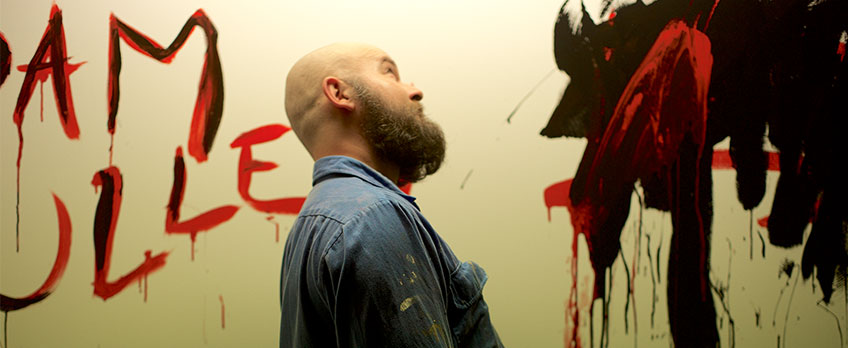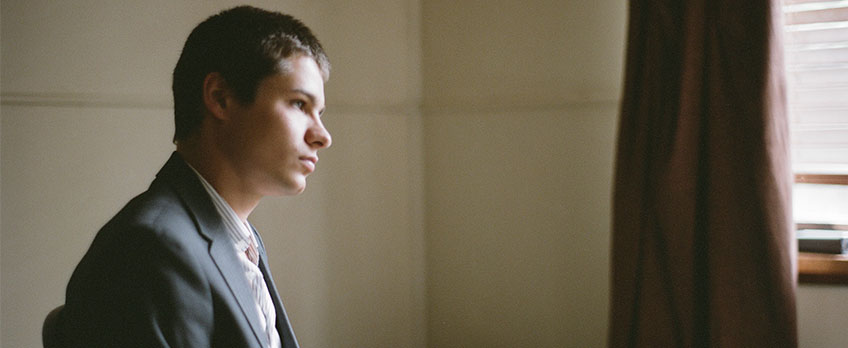Q&A with Acute Misfortune director Thomas M. Wright

How did you go about portraying an honest depiction of characters, Adam Cullen and Erik Jensen and their relationship when the film is adapted from the perspective of Jensen’s novel of the same name?
There were almost four years of research and writing that went into the film. Outside of the intensive process of writing the film with Erik, I read almost everything written about Cullen and met many times with his father, Kevin, and art dealer Jason Martin, the executors of his estate; and with Adam’s former partners and contemporaries. I spent time with his critics, painting assistants, his drivers, the nurses and doctors who cared for him in his last years in and out of hospital, and, in counterpoint to that, with his drug dealer. I also spent time researching Erik at that time, at the Sydney Morning Herald and with friends, former partners and associates. The film isn’t about repeating the conclusions of the book. The film questions those conclusions, reframes them and situates the biography as a part of the relationship and not, as the lining of the book says, as a work written ‘without judgement’.
It’s also worth saying that biographical cinema is by its nature dishonest. When you attempt to compress four-and-a-half years into 90 minutes, with people representing other people, you are recreating a position or impression out of those conditions. I think as a filmmaker you have to be aware of that. The family and associates of Adam and Erik have been really convinced by what the film represents though.
Jensen also co-scripted the film. Of what importance was it to the narrative and writing of the film to have his input?
The film could not have been written without Erik. We worked together very closely for three-and-a-half years on the adaptation. It was an immersive and often difficult process. The writing of the film revealed a lot about his relationship with Adam - and that was necessarily confronting, though, in the end, it was cathartic and created the film that it is.
What was it about the dynamic between these two individuals that attracted you to make a film about them?
The reasons for making a film are bound to shift over the four years, or more, of research, development, writing, filming and completion - though it had to do with what they represented - with the tension between their differences and how they reflected one another. The generational differences were compelling to me, both individually and in terms of the shifting conditions and culture of this country.

Stylistically, how does the film illustrate Jensen and Cullen’s passion for their individual creative outlets in writing and painting?
This is really a form and content question. The form of the film is partly that of a literary detective story, where we draw closer to Cullen through his life and work - cutting through the layers of persona to approach his underlying character. We do this through Erik’s life and work as a journalist. In terms of the content, in making a film about an artist there is the inevitable question of whether you owe a debt to their aesthetic. Our answer was that we did not - instead, we took as our task to interrogate the ideas at the core of Cullen’s practice. What was he saying? What was he unpicking? What were his reasons and intentions in making the work? And that led us to the form and language of the film - because I saw those reasons and intentions as being directly tied to his early death. And a lot of cinema that tries to ape an artist's aesthetic ends up undermining both the work on which it's based and the film itself, especially when it’s a literal attempt.
Acute Misfortune was shot in the Blue Mountains in NSW where Cullen was based. Was there a sense of place that was an important aspect in the portrayal of Cullen’s character?
It was essential to us to film in the mountains, in the towns where Adam lived and worked. It is a profound place to make a film, both practically and in terms of the meaning if offers. The mountains are physically imposing, beautiful, and full of complex histories and people. Adam situated himself there for that reason. He had an underlying feeling for the hidden histories in our landscape, though his work was less concerned with the landscape itself than on its impact on people. He painted on a flat picture plane - and actually, his Master's thesis was on the ‘psychic geography of the Australian landscape’, so it’s rare that we use the mountains as a literal landscape for setting the film, though occasionally they rear up in all their beauty, drama and scope. The meaning and function of the trains and the train line, cutting up the mountains, became significant to the film.
Dan Henshall was dressed in Cullen’s actual clothing for the film. With respect to Cullen, how did you guide Henshall into Cullen’s character - a troubling man in decline in his final years?
To be clear, not all of the clothes that Dan wears were Adam’s - though many of the pieces of his wardrobe and set dressing, props and painting materials were. Dan painted with Adam’s brushes in the film, which is probably more personal and significant than anything else. Dan was attached to the film very early in its development. Early in the writing of the film, I handed Erik a copy of Snowtown and told him to watch the person playing John Bunting. He called me that night and said ‘he has to represent Adam in the film’. Two-and-a-half years later I filmed a proof of concept for Screen Australia with Dan and when I showed Adam’s family, they turned to me afterwards and asked where I had found the archival footage - because they had mistaken Dan for their son and friend. Dan’s research began almost three years before we filmed and was very comprehensive. During the actual shoot Dan had the difficult task of representing Adam’s descent through the film and lost about 22kg, which definitely helped to embody Adam’s physical and mental state. I have to say here that Toby Wallace’s portrayal of Erik Jensen in the film was no less intensive or committed. He took it on as a profound responsibility and I think it’s a career-defining, emotional and psychological performance from him.
Some of Cullen’s original artworks are displayed in the film. What choices did you make about what pieces were featured? Were some works more significant to the storytelling of the film?
Definitely. And there is a more involved discussion to be had about that than we can attempt here. One of the things that drew me most to the book was the way that Erik used the work as a key to unpick Cullen’s underlying psychology and intentions - and we debated how to depict his work, and which work to represent, endlessly throughout the filmmaking process and right until the end of the edit. In the end there are over twenty original Cullen works represented in the film and we see him making work in many contexts.
As a MIFF Premiere-supported film, Acute Misfortune is having its world premiere at MIFF this year (2-19 August). Can you tell us a bit more about the release through MIFF?
MIFF Premiere Fund was the first funding body to offer support to this film. I have been coming to MIFF since I was about 14 years old - when I woke up to cinema. And I couldn’t be more proud to be a recipient of MIFF Premiere Fund support or to be opening the film here, in the city I have always lived, and at this festival which completely opened the possibilities of cinema to me.
I also am so proud to be screening the film alongside some of my closest friends and contemporaries: with Thomas Henning, my partner in the theatre company Black Lung that we founded in 2006, who has produced and directed the feature ‘EMA NUDAR UMANU' shot entirely in Timor Leste some six years after we created the theatre production Doku Rai there with MIFF Accelerator Lab alumnus director Amiel Courtin-Wilson and ten years after Robert Connolly and I went there to film BALIBO; and alongside Alena Lodkina and Kate Laurie whose film STRANGE COLOURS is one of the strongest and most striking independent Australian films I have seen in the past few years; and MIFF Accelerator Lab alumna Miranda Nation, whose MIFF Premiere Fund-supported film UNDERTOW is also world premiering at the festival. Another of my closest friends and contemporaries, Shelly Lauman, has her short BIRDIE playing in the program.
I couldn’t be more proud to be screening this film in their company.